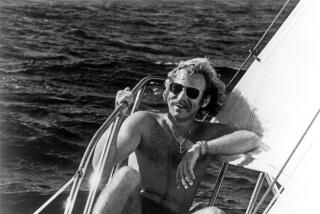Recalling Memorable Melodies of Burt Bacharach
- Share via
“We weren’t trying to write yesterday’s hit tunes,” says lyricist Hal David at the start of “Burt Bacharach: This Is Now,” a “Great Performances” documentary on PBS tonight.
And David, who teamed with Bacharach for some of the ‘60s’ most memorable pop tunes, is right on target with the remark. Amid the burst of pop music creativity that took place during the decade, from the Beatles to Bob Dylan to the Rolling Stones, the Bacharach-David team produced music that insistently maintained its own creative identity. Neither rock nor traditional pop, but including elements of both, as well as traces of jazz and classical music, the Bacharach melodies--then and now--are some of the most remarkable achievements in popular music.
The documentary--which is dramatically enlivened by intimate interviews with Bacharach and David, as well as endlessly fascinating performance clips--tracks Bacharach’s career in considerable detail. There are photos from his youth, reminiscences of his early composition study, recollections of the early days at Manhattan’s song-writing mecca, the Brill Building, clips of his conducting tours with Marlene Dietrich and a series of performance shots that chronicle the entire process of his hair transforming from black to distinguished white.
*
In one of his many illuminating comments, Bacharach describes studying with the famous French composer Darius Milhaud. Taking a sonatina to Milhaud for an assignment, Bacharach was “embarrassed” over the fact that one of the movements contained an attractive melody, at a time when most composers were aggressively moving toward dissonance.
But Milhaud looked at the piece and, according to Bacharach, commented, “Burt, never ever feel embarrassed or discomforted by a melody that people can remember or whistle.”
It obviously was a comment that Bacharach took to heart. But he was receptive to other influences as well. He mentions the importance of bebop in his early musical experience, as well as the music of Impressionist composers Ravel and Debussy.
What becomes clear in this fascinating overview--profuse with interviews with such Bacharach associates as Warwick, Herb Alpert, Richard Carpenter and Dusty Springfield, as well as newer fans Elvis Costello and Noel Gallagher (of the group Oasis)--is the manner in which Bacharach combined all these influences and attitudes to create his own, unique musical voice.
Along the way, he notes, “I sacrificed a few good songs,” explaining that he was told in his early career that “you can’t have a three-bar phrase” or that pop songs couldn’t be written in unusual meters. Eventually, he proved the contrary, creating a catalog of unique popular songs--”Walk On By,” “I Say a Little Prayer,” “Close to You,” “I’ll Never Fall in Love,” “This Guy’s in Love With You” among dozens of others--that managed to be melodically memorable in a framework that often incorporated many of the forbidden elements of disjunct phrases and off-beat rhythms.
* “Burt Bacharach: This Is Now” airs at 9 tonight on KCET-TV Channel 28.
More to Read
The biggest entertainment stories
Get our big stories about Hollywood, film, television, music, arts, culture and more right in your inbox as soon as they publish.
You may occasionally receive promotional content from the Los Angeles Times.










